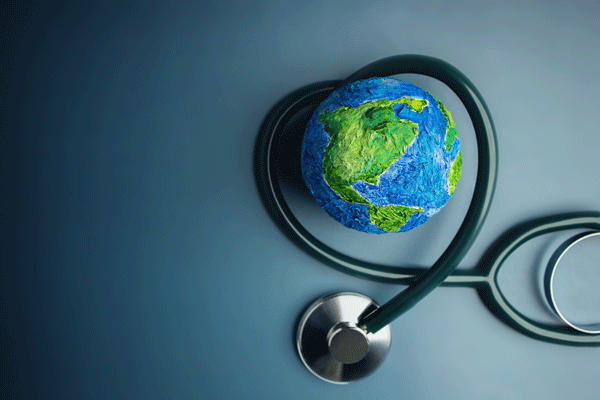Why is green technology so important in healthcare?

The healthcare sector is uniquely placed in these times of environmental crisis by contributing to climate change and pollution while bearing the brunt of its consequences. The fundamental objectives of any healthcare service are to save, prolong and enhance lives, and to ‘do no harm’. These core philosophies are very much aligned with green priorities. That is why green technology is so important in healthcare.
What is it and why is green technology so important in healthcare?
Green technology is how we develop and utilise products and systems that conserve the environment in healthcare activities while reducing any negative impacts. It needs little explanation to see how this enhances individual and public health outcomes as well as reducing the strain on healthcare services.
The impact of environmental damage on healthcare
The health impacts of environmental damage are well documented. The effects of climate change threaten to undermine gains made in public health during the past 50 years. Respiratory illness, heart disease, stroke, some cancers and direct injuries are caused by pollution, poor air quality, waste, unsafe drinking water and events arising from climate change such as wildfires, flooding and extreme weather events.
The impact of Covid-19 has put additional strain on healthcare systems around the world and only added to the impact on the climate and on societal inequalities. Additional activity in intensive care services, mass vaccinations and the increased requirement for single-use PPE has increased energy usage, emissions and the production of waste.
The twin emergencies of the environmental emergency and a growing healthcare crisis mean that the sector must lead by example. That means health leaders, policymakers and individual facilities and staff must work together to reduce emissions, minimise waste and adopt ‘green’ policies to reduce people’s vulnerability to future threats and therefore reduce the burden on health services. This cannot be achieved without harnessing new technology.
How healthcare services actually contribute to the environmental crisis
The healthcare sector is said to contribute 4% of global greenhouse gas emissions. Breaking down this contribution further demonstrates where steps can be taken to make incremental gains in reducing pollution generated by the sector. A 2019 analysis of NHS activity in England found that of emissions:
- 62% came from the healthcare supply chain.
- 24% from the direct delivery of healthcare to patients.
- 10% from staff commutes and patient and visitor travelling.
- 4% from private services commissioned by the NHS.
The size of the single overarching provision of healthcare in the UK presents a unique opportunity to leverage its influence on reducing the carbon footprint of the NHS and other activities harmful to the environment and to health. The NHS is the largest publicly funded healthcare system in the world and the biggest employer in Europe. Driving emission volumes downwards in the NHS has the potential for significant impacts. The NHS has committed to cut its carbon footprint from direct operations to net-zero by 2040 and by 2055 within its entire supply chain.
Not only that, but the UK has a sizeable and fragmented mixture of private and publicly-funded health and social care provisions that operate alongside and outside of the NHS. Initiatives within the NHS can serve as a model to drive green programmes across the entirety of this additional provision.
The benefits of reducing the impact of healthcare on the environment
There are many coordinated initiatives underway within health services to reduce the impact of pollution and the production of greenhouse gases. All of the following, many of which utilise green technologies, have benefits for consumers of healthcare services on a local, national and global level as well as contributing to wider positive public health and patient outcomes:
- The production and consumption of green energy
- Sustainable food sourcing
- Healthier homes and neighbourhoods, notably achievable through primary care
- Keeping harmful items out of the environment
- Reducing the prevalence of single-use plastics
- Environmentally-focussed purchasing
- Green chemistry - chemical products and processes that reduce or eliminate the use and generation of hazardous substances.
- Improving the air quality and ventilation within facilities, plus enabling more light
- The use of non-toxic cleaning chemicals.
Clinicians and other healthcare professionals can play an important part in reducing environmental harm from the provision of services. It is likely that there remain knowledge gaps in how this can be achieved among individual practitioners. Most notably, there are opportunities to prevent waste. Seemingly small changes in how medical supplies and protective equipment are used (in line with national and local guidance) can have substantial benefits to conserve resources and minimise waste. When magnified across an entire facility and the sector as a whole this has a significant impact.
The utilisation and benefits of green technology in healthcare
The field of green technology in healthcare encompasses a continuously evolving group of methods and materials, from techniques for generating energy to the use of energy, direct patient care provision, lab services and ancillary activities such as cleaning, catering and waste disposal.
For example, green hospitals are increasingly being designed to utilise renewable energy such as geothermal energy for heating, cooling and hot water. Here, ground source heat pumps harness solar energy absorbed by the earth. 40% of the total energy consumption of a typical hospital comes from its Heating, Ventilating and Air Conditioning (HVAC) systems. Green HVAC systems can significantly reduce the amount of energy, and, in turn, greenhouse gas emissions.
Using technology to enhance initiatives to develop optimised workflows in the design and refurbishment of healthcare facilities reduces waste and emissions, lowering the impact on the environment. It also contributes to the overall efficiency, improving patient outcomes through reduced waiting times, more effective procedures and treatments, and enabling providers to better track patient journeys. Delivering care closer to home is more person-centred and also reduces transport emissions, as does implementing fleets of zero-emissions ambulances.
Furthermore, the focus on green and sustainable healthcare spaces transforms the provision from being a clinical place where people go to receive treatment into one with an additional focus on overall and long-term wellbeing. It improves patient outcomes and enables both staff and patients to feel they are contributing to goals beyond direct healthcare itself.
Green advances are also seeing healthcare providers increasingly working in partnership and collaboration with others with the expertise in technology to deliver progress to environmental targets and deliver ‘greener’ healthcare. This has long term benefits for the sector in utilising technology as a means to achieve positive outcomes.
Green jobs in healthcare
The Covid-19 pandemic accelerated investment in healthcare jobs. Employment opportunities are being created with a focus on promoting green principles and putting them into practice. Alongside this, what we’re increasingly seeing is an element of ‘green’ and of ‘sustainability’ being built into the full spectrum of healthcare roles. We are seeing specific responsibilities, even protected time, being incorporated into role specifications to achieve environmental and sustainability outcomes.
If environmental considerations and green technology are a passion of yours in delivering healthcare and positive outcomes for individual patients and wider public health, take a search through our current listed vacancies to find a role in which you can make a true difference.

Refer A Friend & Help Save The Planet
With every referral you now make to us, we grow a tree, and also reward you for the people who you refer.





